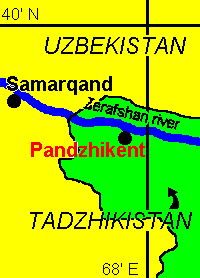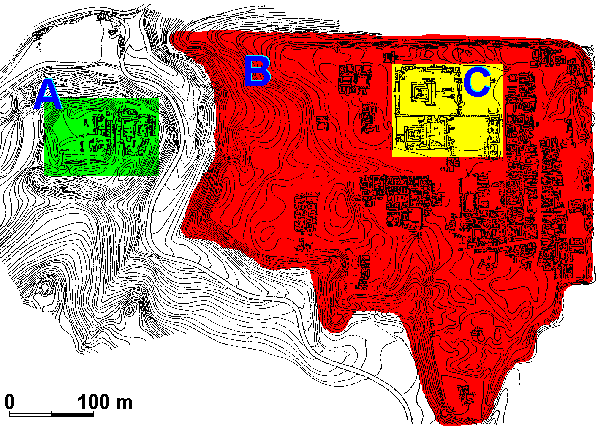
Institut für Altertumswissenschaften
Seminar für Orientalische Archäologie und Kunstgeschichte
 | Martin-Luther-Universität Halle-Wittenberg Institut für Altertumswissenschaften Seminar für Orientalische Archäologie und Kunstgeschichte |
| |||||||||||||||||||||
| Pandzhikent - a town site in ancient Sogdia | ||
 The ruins of ancient Pandzhikent are situated in the Zarafshan valley, some 53 km east of Samarqand and immediately on the southern outskirts of the present day Tadzhik town of Pandzhikent.
The ruins of ancient Pandzhikent are situated in the Zarafshan valley, some 53 km east of Samarqand and immediately on the southern outskirts of the present day Tadzhik town of Pandzhikent.
This site is under excavation since 1947, subsequently led by Yu. A. Yakubovskiy, M. M. Dyakonov and A. M. Belenitskiy. Current field director is B. I. Marshak (of the St. Petersburg Hermitage Museum), working together with V. I. Raspopova and V. G. Shkoda.
Ancient Pandzhikent was a small but rich town of the Soghdians, a people of Iranian language ranging among the most important peoples of pre-Islamic Central Asia. The ethnic and territorial name "Soghd/Soghdian" occurs in historical sources as early as in Achaemenid times (6th century B.C.). In their heartland, the Zarafshan valley, they founded several city-states, as well as colonies along the ancient Silk Routes from Eastern Europe (Crimea) to the Chinese border and Mongolia.
In the central Zarafshan valley, the town of ancient Pandzhikent (Soghdian: Panchekanth) was the capital of Panch and its rulers. The town probably arose in the 5th century A.D. Its citizens were well established businessmen and landowners. In A.D. 722, Arabian forces besieged and took the town. The last ruler Devashtich fled into the upper Zarafshan regions where he was captured and sentenced to death shortly after. For some 50 years, ancient Pandzhikent stayed a living place under the new rulership, but towards the end of the 8th century the place was given up and never resettled again. Therefore, quite a lot of urban remains, architecture and works of art from the last urban phases could await the spades of the archaeologists.

The town was divided into a larger residential part (shakhrestan; plan: B) which covered an area of about 13 hectares, and a citadel (arq) with palace (about 1 hectare; plan: A). A narrow wadi separates both quarters and their fortifications, but there has been a bridge to connect them.
In the shakhrestan two major temples (plan: C) were established early in the town's life. These temples mark the focus of the entire urban area. They defined the direction of streets and living quarters around them - at least initially.
All architecture at Pandzhikent consisted of mud bricks and pakhsa (a kind of stamped mud). The houses reflect different social ranks - from large estates to single-room flats. Multi-storeyed houses consisted of living areas, economic quarters and ritual constructions. Some of them were associated with large courtyards - an exeptional privilege in a town of extremely restricted spatial resources. Urban activity outside the houses was concentrated on the temples and, economically, on a bazaar with small shops (area XVI).
One of the most interesting features of the larger houses are halls with four columns and benches along the walls. Obviously, they served for ritual and communicative purposes and marked the most important parts of the houses. Here - as well as in the temples - the excavators revealed many mural paintings.
The paintings from Pandzhikent cover stratigraphically and by style the entire history of the town, i.e. from the 5th up to the 8th centuries A.D. Therefore, and because of their quality and thematic variety, they form one of the most important complexes of early mediaeval art in Central Asia and the surrounding areas. In the long history of Oriental art they mark the final heyday before the emergence of Islamic art.

Among the murals we find narrative cycles of myths and epics (picture above: death of an Amazon queen; area XXII, room 1), furthermore representations of folk-tales (picture below: the goose that laid golden eggs; from the same room) and various ornamental compositions.

Several Soghdian gods and goddesses appear in the paintings: The images of deities (sometimes more than life-sized they served as ritual icons) are a unique iconographic complex of Iranian religious art. Some of the great narrative murals turned out to be pictorial variants of the well-known Rostam story. These variants don't occur in the later famous work of Firdusi.
Today, the paintings are preserved in Dushanbe, Pandzhikent and - for the major part - in the St. Petersburg Hermitage. Restorers of the institution just mentioned have developed special methods to preserve the murals both under fieldwork conditions and in the museums.
Further excavations at the site of ancient Pandzhikent will certainly enlarge our knowledge of the Soghdians, their economic conditions, their cultural efforts as well as their contribution to the art history of mankind.
For further reading:
M.Mode
| update: 1998-02-02 |
| ||||||